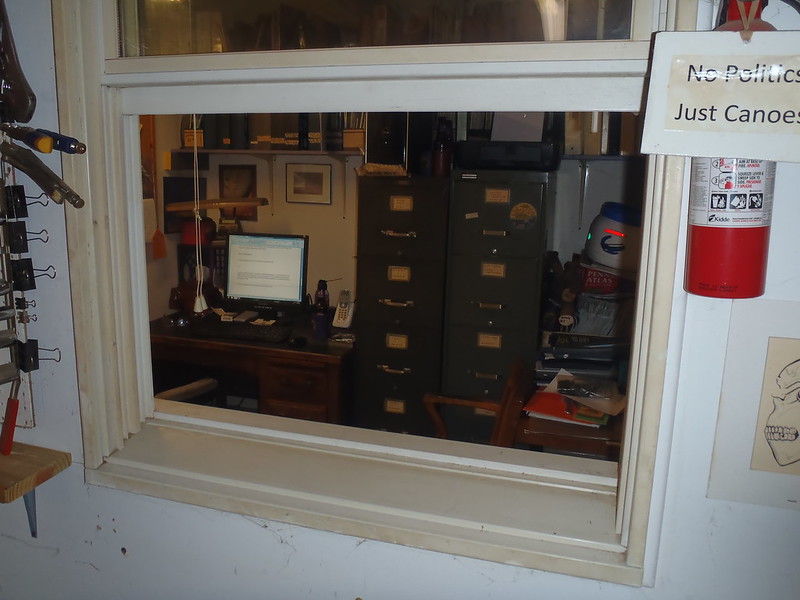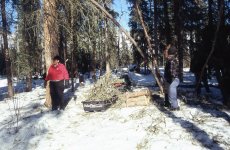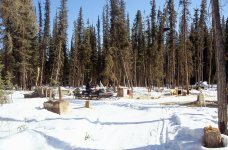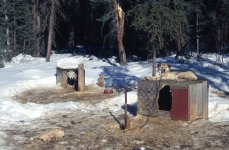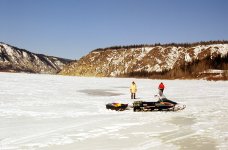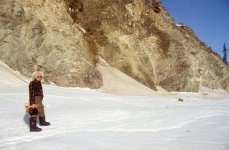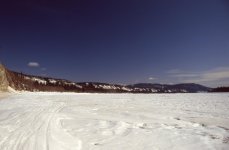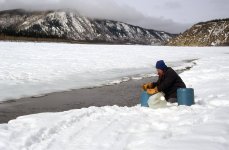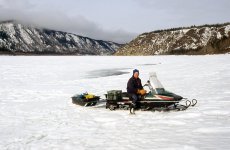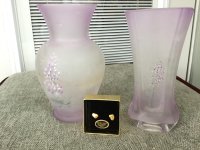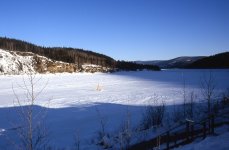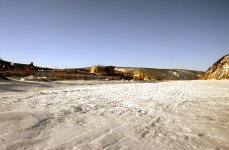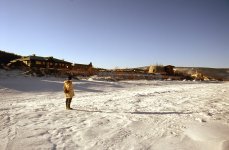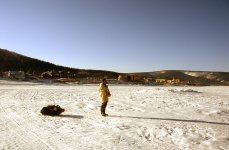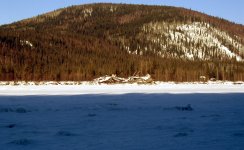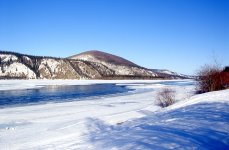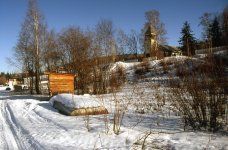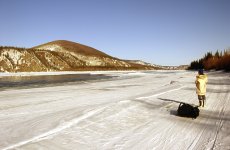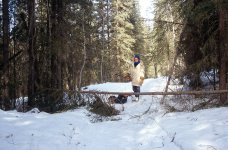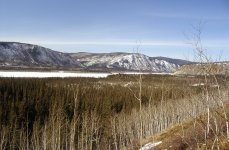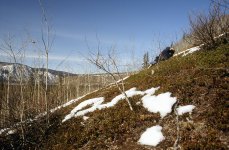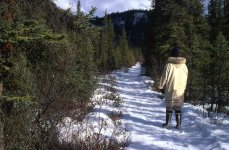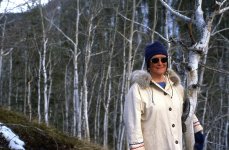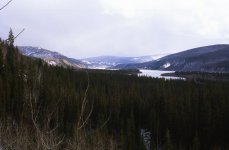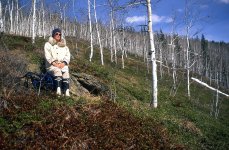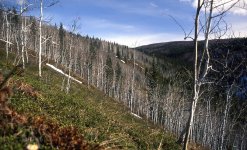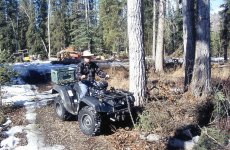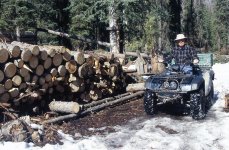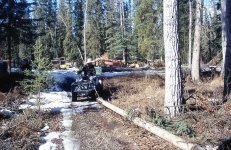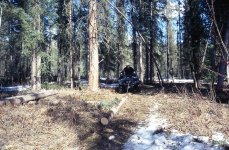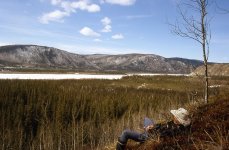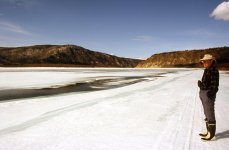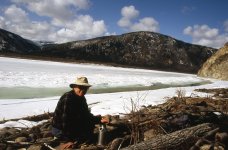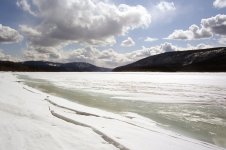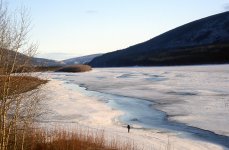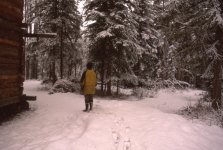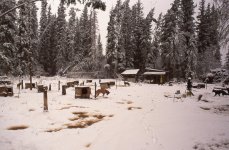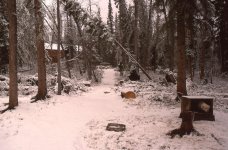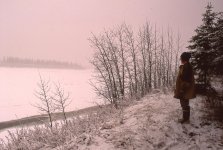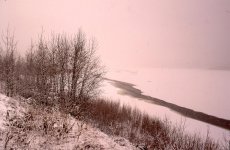- Joined
- Aug 21, 2018
- Messages
- 1,726
- Reaction score
- 1,914
Breakup!
Fort Reliance, Yukon River, 2006
In 1993, Kathleen and I sold our suburban home in North Vancouver and moved to a one-acre, ocean-side retreat on Pender Island, approximately halfway between Vancouver and Victoria. Here we intended to live a rural life-style, with days devoted to ocean paddling, walks on forest trails to coffee shops, gardening and ‘doing as we pleased.’
At first Kathleen and I were very happy. We both believed that we would never leave Pender Island, a place considered by most of our friends and family to be among the best locations one could live in Canada. But during summer, tourists sped along the narrow, winding island roads, while sea-doos and power boats roared past our bucolic home. During winter, rain and grey skies blotted out the sun, seemingly for weeks at a time.
By January of 2006 we could no longer ignore the irresistible call of Canada’s peaceful North. We longed to walk on frozen rivers beneath the winter sun. We wished to know once again the exhilaration of seeing the ice finally release its grip on the frozen landscape. Breakup at the outlet of Colville Lake, north of the Arctic Circle, where we wintered from January 31 to mid-June in 1999, had been tremendously exciting. Butour original plan back then had been to witness breakup on a large river, such as the Yukon. Dawson City had always been a favourite place for us to visit during summer. Could we possibly find a winter cabin to rent on the Yukon River near the historic gold rush town of Dawson?
During a conference call in January of 2006 with my fellow executive members of Paddle Canada, Trevor Braun, in Whitehorse, gave me the phone number of Tommy Taylor, who owned a cabin on the right bank of the Yukon River, 13 km (eight miles) downriver from Dawson City. I called the next day.
“How much to rent your cabin from approximately April first to breakup?” I asked.
“How ’bout we make a deal?” Tommy replied.
This didn’t sound promising to me. By ‘a deal,’ I assumed that Tommy wanted me to do something useful, like build a cabin. I didn’t, and still don’t, have those kinds of skills. My deal would be to pay Tommy some money while we stayed at his place.
“What kind of deal do you have in mind?” I asked.
“You look after my 29 sled dogs, and you can stay for free. There’s no roads to my place at Fort Reliance, where I keep the dogs. During the winter I can go down there by ski-doo. During summer I can go down there by boat. But during breakup, I can’t get down there to feed the dogs. I work in town, so I need to have someone there.”
“That sounds good to me, Tommy, but I’ll have to talk to my wife, Kathleen.”
Kathleen was not very enthusiastic. “We don’t know very much at all about taking care of
dogs, Michael. I know that we helped out for three weeks when we visited Marilyn and Alan in Inuvik in January of 1999. But we were just helpers. Maybe taking care of 29 dogs would be too much for us. Why don’t you call Alan, and see what he says?”
So I called Alan, who was very enthusiastic. “It’s a great opportunity, Mike. It will be an adventure.”
So I called Tommy back, and said that we planned to arrive in Dawson City on approximately March 30. On the way up, we spent our last night on the road at a motel in Whitehorse. I dialled Tommy’s phone number in Dawson City, and his wife, Dawn Kisoun, answered the phone. “I was wondering, Dawn, if there’s anything you would like us to bring up from Whitehorse?”
“Yep. There’s some dog food that we have ordered that you can pick up for us. And also, I would love it if you could bring me a large double double from Tim Hortons.” (Note: For those of you who might not know, a ‘double double’ is a coffee with two creams and two sugars. It is somewhat of an iconic drink in Canada.)
The next day, we picked up the dog food, bought the large double double, and headed up the North Klondike Highway, 533 km (330 miles) to Dawson City. About half way there, just north of Carmacks, we stopped at the Five Finger Rapids Recreation Site. There was more open water in the rapids than I expected to see. “This is not good Kathleen. I hope that breakup is not coming quickly this year. I hope it hasn’t already begun.” (Note: I don’t know if some open water always remains in Five Finger Rapids, even during winter. I think it is likely, though.)
We arrived in Dawson City on March 30, at -25 C (-13 F). That seemed cold enough to discourage a quick breakup. We called Tommy for directions to his house. He lived only a few blocks away. We drove over and parked our van behind his house in the early evening.
We knocked on the door, and were warmly welcomed by Tommy and Dawn. We lugged some of our gear into the spare bedroom, and then joined Tommy and Dawn at the kitchen table. We handed Dawn her large double-double from Tim Hortons, just as someone else knocked at the front door. A next door neighbour joined us at the kitchen table. Almost immediately her eyes riveted on Dawn’s large double double. “Where did you get that double double, Dawn? I am so envious!” Apparently we should have brought at least two large double doubles from Whitehorse.
Kathleen and I spent the next couple of hours chatting with Tommy and Dawn about our upcoming adventure. Tomorrow we will travel by ski-doo down to Tommy’s cabin and dog yard at Fort Reliance, where we will live until breakup, whenever that might be.
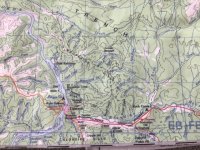
The following information is from: https://en.wikipedia.org/wiki/Fort_Reliance
Fort Reliance is an abandoned trading post in the Yukon Territory of Canada. It stands on the east bank of the Yukon River 13 kilometres (8.1 mi) downstream of the town of Dawson City. The fort was established in 1874 by François Mercier, Jack McQuesten and Francis Barnfield for the Alaska Commercial Company to accommodate fur trading with the native Hän people.
Trading at Fort Reliance continued uninterrupted until 1877. During this time, the post became a major landmark for traders. The Fortymile River, Sixtymile River and Seventymile River were named for their distance from the fort. In 1877, traders abandoned the fort after natives stole their goods.Traders returned in 1879 and operated the fort until 1886, when it was abandoned due to a gold strike on the Stewart River. The gold strike diverted traders' attention from fur trapping, and thus the fort assumed less importance.

Jack London Grill at the Downtown Hotel. Image from https://downtownhotel.ca
Friday, March 31. Kathleen and I woke early, and walked two or three blocks over to the Downtown Hotel for breakfast. Still reassuringly cold at -25 C (-13 F). Nails popped loudly beneath our feet as we strolled along the wooden sidewalks. We seemed to be the only people out and about. We were headed for the Jack London Grill, which had been recommended by Tommy and Dawn.
We both ordered the breakfast special, a large meal served with unending cups of hot coffee. Other than the staff, Kathleen and I were the only ones there. We sat at the table in the front left of the room. It became ‘our table.’ We have sat at that table every time since then. Well, almost every time. During our last visit to Dawson City in July 2019, two other couples occupied our table. We had to move over to the table in front of the second column in the centre of the room. Very disconcerting.
The Downtown Hotel is probably most well known for its Sourtoe Cocktail, a beverage that contains a mummified human toe. Those wishing to be initiated into ‘The Club’ in the Sourdough Saloon are advised that “You can drink it fast. You can drink it slow. But your lips must touch the toe.” Neither Kathleen nor I have ever desired to caress that mummified human toe with our lips.
After breakfast we returned home, where Tommy was preparing two ski-doos to haul our gear and supplies to Fort Reliance. “So, Mike, do you want Kathleen to ride with you or with me?”
“Well, Tommy, I haven’t driven a ski-doo since January of 1999. And then only for one day. I’m not all that experienced. And you know the river better than me. We saw open water in Five Finger Rapids. If I happen to go through some thin ice between here and Fort Reliance, it’s best that Kathleen be riding with you.”
With that, Kathleen climbed onto the back of Tommy’s skidoo, and they roared off the short distance down to the Yukon River. I climbed onto my ski-doo, tentatively opened the throttle, and crept slowly out of Tommy’s yard. A few seconds later, I reached an intersection with a stop sign. I obey traffic laws. I stopped, even though there was no one else out and about in Dawson City. I looked both ways. No traffic. Safe to proceed. I opened the throttle, but the skidoo didn’t move. I gave more gas, but the tracks simply spun. dang. I told Tommy I didn’t know what I was doing. (Note: What I have learned since that morning is that in intersections, where vehicles stop and start, the snow generally becomes compacted enough to form ice. I was also pulling a load. The ski-doo stubbornly refused to even budge.)
What to do? I got off the ski-doo, and yanked it back and forth to pull it onto the gravel at the side of the road. I climbed back on and somewhat aggressively drove down to the river where Tommy was sitting crosslegged, with his arms folded, on his ski-doo. “So, Mike,” he said. “There’s a reason they call it a snow mobile, and not an ice mobile.” That made sense to me.
Anyway, off we went to Fort Reliance, down the Yukon River, without any more problems. We dropped off our first load, and then headed back to Dawson City along the bush trail. Tommy wanted to show us as much as possible about our new home. After about 3.5 km (2 miles) we reached Fourth Creek, where Tommy slowed and stopped. Overflow had turned the surface of Fourth Creek into a somewhat steeply rising sheet of ice. Not my forté. At least not yet. Tommy drove both ski-doos across Fourth Creek.
When we reached Clear Creek after another couple of kilometres, Tommy stopped to tell us that Peter and Marion lived here, a short distance below the bush trail. “They’re great people. If you should have any trouble, just come here, and Peter and Marion will help you.”
When we reached the First Nation’s village of Moosehide, we drove down onto the Yukon River, to bypass the the steep cliffs leading up to Moosehide Slide. Back in town, we parked in front of the Tr’ondëk Hwëch’in Community Hall for a lunch. We sat down at a long table next to two older men. One of them turned to me and asked, in that characteristic cadence and accent of first nations speakers: “So. You da guy who got stuck in town this morning?”
Yeah, that would be me. I didn’t see anyone else getting stuck in town this morning. I don’t know how he knew. As I have said before. No one else was out and about.
The following information is from http://www.yukoncommunities.yk.ca/da...first-nations: The Tr’ondëk Hwëch’in have been a self-governing Yukon First Nation since 1998. Descendants of the Hän-speaking people have lived throughout Yukon and along the Yukon River for millennia, and comprise a diverse mix of families descended from Gwich’in, Northern Tutchone and other language groups.
Anyway, after a pleasant lunch of caribou stew and bannock, we headed back to Tommy’s place to get our second load of gear and supplies. Dawn joined us on this trip to Fort Reliance. Kathleen rode with me this time. I didn’t stop at the stop sign. I’m a quick learner.
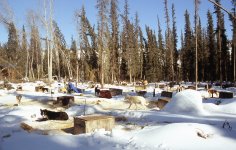
Back at Fort Reliance, Dawn introduced us, by name, to each of the 29 dogs.
Next, Tommy explained, and demonstrated, how we were supposed to feed the dogs. Each morning we would be cooking a mixture of rice, kibble, meat and frozen salmon in four large pots over an open fire. When we had first arrived at the cabin, Kathleen noted a fairly strong smell of meat. Tommy explained. “I have slabs of meat stored in a shed. Each day you gotta bring enough meat into the cabin to thaw to cut up into smaller pieces. Every once in a while I will bring out more meat. People are clearing out their freezers now, and I often get road kill.”
Kathleen asked, “How do we know when the food is done?”
“Easy,” Tommy said. “When the fish eyes float to the top. Then you carry the pots through the dog yard and ladle out one scoop for each dog.”
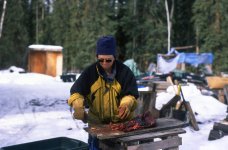
Kathleen cutting up meat for the dogs. Image taken April 5.
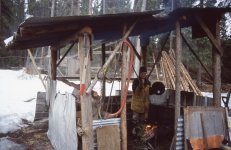
Kathleen cooking dog food until the fish eyes float to the top. Image taken May 4.
“Twenty-nine dogs make a lot of poop, Tommy. What do we do with all the dog poop?”
“You go through the yard each day, and collect the poop in this toboggan. Then you drag it down that trail over there, and dump it in the poop hole.”
So that’s what I did. I shovelled poop into the toboggan, and trundled down the trail to the poop hole. When I arrived, however, there was no poop hole. More like a poop mountain. But hey, no need to quibble over semantics.
Next, we were shown where to get water, not only for ourselves, but also for cooking the dog food. Each day I would be sliding a toboggan down the hill to where there was an open lead of water. Tommy said that I was free to use the ski-doo to drag the water back up the hill. You know me and ski-doos, though. Most of the time I dragged the toboggan back up the hill by hand. Not only was it good exercise, but man-hauling also avoided the risk of plunging the ski-doo into the river.
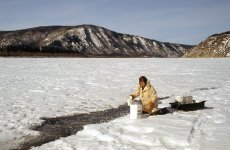
Me getting water for the dogs.
Our cabin was heated with a large wood stove. Tommy wanted to see if I was capable of splitting wood. “OK, Mike. Now we’re going to have a wood-splitting contest. Select any of those tools over there that you prefer.”
The rounds were pretty big. I had done a fair amount of wood-splitting since we moved to Pender Island in 2003. But generally I split smaller rounds. I had seen a woman neighbour of ours, Sandy, splitting large rounds with a sledge hammer and a splitting wedge. I looked over, and saw a splitting wedge and a sledge hammer. I said, “I’ll use those, Tommy.”
Tommy shook his head and said, “No. Those are a woman’s tools.”
So I selected an axe, and the contest began. Tommy split his round on the first swing. I eyed my round, and hit a glancing blow. The round remained intact. Tommy shook his head again, and said, “Mike, accuracy is the key.” (Note: Since moving to Preeceville in 2008, I have split, by hand, about six cords a year. I think I’m pretty good at it. Every once in a while, though, I still strike a glancing blow. I then mutter to myself, “Mike, accuracy is the key.”)
Tommy then showed me the chainsaw, and the jerry can with the gas/oil mixture. “Can you use a chainsaw Mike? You will need to be cutting more wood to cook the dog food.”
“I’ve been using one for the last two years, Tommy. I think I’m OK with it.”
All four of us then went into the cabin, and climbed the stairs to the large open-plan sleeping area. We spread out our sleeping bags and went back down for supper. “Say, Tommy. I noticed that there’s no outside stairs to get out of the cabin if there’s a fire at night. What do you do if there’s a fire?”
“Don’t have a fire.”
That made sense to me.
The night featured a vibrant display of Northern Lights. It had been a very good first day at Fort Reliance. Kathleen and I were situated in a comfortable, roomy cabin. We were ready to take care of the dogs. We looked forward to witnessing winter progressing to spring. We looked forward to seeing breakup on the Yukon River.
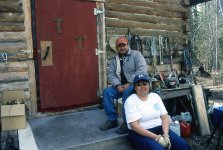
Tommy and Dawn in front of their Fort Reliance cabin. Image taken May 21, our last day at the cabin.
Fort Reliance, Yukon River, 2006
In 1993, Kathleen and I sold our suburban home in North Vancouver and moved to a one-acre, ocean-side retreat on Pender Island, approximately halfway between Vancouver and Victoria. Here we intended to live a rural life-style, with days devoted to ocean paddling, walks on forest trails to coffee shops, gardening and ‘doing as we pleased.’
At first Kathleen and I were very happy. We both believed that we would never leave Pender Island, a place considered by most of our friends and family to be among the best locations one could live in Canada. But during summer, tourists sped along the narrow, winding island roads, while sea-doos and power boats roared past our bucolic home. During winter, rain and grey skies blotted out the sun, seemingly for weeks at a time.
By January of 2006 we could no longer ignore the irresistible call of Canada’s peaceful North. We longed to walk on frozen rivers beneath the winter sun. We wished to know once again the exhilaration of seeing the ice finally release its grip on the frozen landscape. Breakup at the outlet of Colville Lake, north of the Arctic Circle, where we wintered from January 31 to mid-June in 1999, had been tremendously exciting. Butour original plan back then had been to witness breakup on a large river, such as the Yukon. Dawson City had always been a favourite place for us to visit during summer. Could we possibly find a winter cabin to rent on the Yukon River near the historic gold rush town of Dawson?
During a conference call in January of 2006 with my fellow executive members of Paddle Canada, Trevor Braun, in Whitehorse, gave me the phone number of Tommy Taylor, who owned a cabin on the right bank of the Yukon River, 13 km (eight miles) downriver from Dawson City. I called the next day.
“How much to rent your cabin from approximately April first to breakup?” I asked.
“How ’bout we make a deal?” Tommy replied.
This didn’t sound promising to me. By ‘a deal,’ I assumed that Tommy wanted me to do something useful, like build a cabin. I didn’t, and still don’t, have those kinds of skills. My deal would be to pay Tommy some money while we stayed at his place.
“What kind of deal do you have in mind?” I asked.
“You look after my 29 sled dogs, and you can stay for free. There’s no roads to my place at Fort Reliance, where I keep the dogs. During the winter I can go down there by ski-doo. During summer I can go down there by boat. But during breakup, I can’t get down there to feed the dogs. I work in town, so I need to have someone there.”
“That sounds good to me, Tommy, but I’ll have to talk to my wife, Kathleen.”
Kathleen was not very enthusiastic. “We don’t know very much at all about taking care of
dogs, Michael. I know that we helped out for three weeks when we visited Marilyn and Alan in Inuvik in January of 1999. But we were just helpers. Maybe taking care of 29 dogs would be too much for us. Why don’t you call Alan, and see what he says?”
So I called Alan, who was very enthusiastic. “It’s a great opportunity, Mike. It will be an adventure.”
So I called Tommy back, and said that we planned to arrive in Dawson City on approximately March 30. On the way up, we spent our last night on the road at a motel in Whitehorse. I dialled Tommy’s phone number in Dawson City, and his wife, Dawn Kisoun, answered the phone. “I was wondering, Dawn, if there’s anything you would like us to bring up from Whitehorse?”
“Yep. There’s some dog food that we have ordered that you can pick up for us. And also, I would love it if you could bring me a large double double from Tim Hortons.” (Note: For those of you who might not know, a ‘double double’ is a coffee with two creams and two sugars. It is somewhat of an iconic drink in Canada.)
The next day, we picked up the dog food, bought the large double double, and headed up the North Klondike Highway, 533 km (330 miles) to Dawson City. About half way there, just north of Carmacks, we stopped at the Five Finger Rapids Recreation Site. There was more open water in the rapids than I expected to see. “This is not good Kathleen. I hope that breakup is not coming quickly this year. I hope it hasn’t already begun.” (Note: I don’t know if some open water always remains in Five Finger Rapids, even during winter. I think it is likely, though.)
We arrived in Dawson City on March 30, at -25 C (-13 F). That seemed cold enough to discourage a quick breakup. We called Tommy for directions to his house. He lived only a few blocks away. We drove over and parked our van behind his house in the early evening.
We knocked on the door, and were warmly welcomed by Tommy and Dawn. We lugged some of our gear into the spare bedroom, and then joined Tommy and Dawn at the kitchen table. We handed Dawn her large double-double from Tim Hortons, just as someone else knocked at the front door. A next door neighbour joined us at the kitchen table. Almost immediately her eyes riveted on Dawn’s large double double. “Where did you get that double double, Dawn? I am so envious!” Apparently we should have brought at least two large double doubles from Whitehorse.
Kathleen and I spent the next couple of hours chatting with Tommy and Dawn about our upcoming adventure. Tomorrow we will travel by ski-doo down to Tommy’s cabin and dog yard at Fort Reliance, where we will live until breakup, whenever that might be.

The following information is from: https://en.wikipedia.org/wiki/Fort_Reliance
Fort Reliance is an abandoned trading post in the Yukon Territory of Canada. It stands on the east bank of the Yukon River 13 kilometres (8.1 mi) downstream of the town of Dawson City. The fort was established in 1874 by François Mercier, Jack McQuesten and Francis Barnfield for the Alaska Commercial Company to accommodate fur trading with the native Hän people.
Trading at Fort Reliance continued uninterrupted until 1877. During this time, the post became a major landmark for traders. The Fortymile River, Sixtymile River and Seventymile River were named for their distance from the fort. In 1877, traders abandoned the fort after natives stole their goods.Traders returned in 1879 and operated the fort until 1886, when it was abandoned due to a gold strike on the Stewart River. The gold strike diverted traders' attention from fur trapping, and thus the fort assumed less importance.

Jack London Grill at the Downtown Hotel. Image from https://downtownhotel.ca
Friday, March 31. Kathleen and I woke early, and walked two or three blocks over to the Downtown Hotel for breakfast. Still reassuringly cold at -25 C (-13 F). Nails popped loudly beneath our feet as we strolled along the wooden sidewalks. We seemed to be the only people out and about. We were headed for the Jack London Grill, which had been recommended by Tommy and Dawn.
We both ordered the breakfast special, a large meal served with unending cups of hot coffee. Other than the staff, Kathleen and I were the only ones there. We sat at the table in the front left of the room. It became ‘our table.’ We have sat at that table every time since then. Well, almost every time. During our last visit to Dawson City in July 2019, two other couples occupied our table. We had to move over to the table in front of the second column in the centre of the room. Very disconcerting.
The Downtown Hotel is probably most well known for its Sourtoe Cocktail, a beverage that contains a mummified human toe. Those wishing to be initiated into ‘The Club’ in the Sourdough Saloon are advised that “You can drink it fast. You can drink it slow. But your lips must touch the toe.” Neither Kathleen nor I have ever desired to caress that mummified human toe with our lips.
After breakfast we returned home, where Tommy was preparing two ski-doos to haul our gear and supplies to Fort Reliance. “So, Mike, do you want Kathleen to ride with you or with me?”
“Well, Tommy, I haven’t driven a ski-doo since January of 1999. And then only for one day. I’m not all that experienced. And you know the river better than me. We saw open water in Five Finger Rapids. If I happen to go through some thin ice between here and Fort Reliance, it’s best that Kathleen be riding with you.”
With that, Kathleen climbed onto the back of Tommy’s skidoo, and they roared off the short distance down to the Yukon River. I climbed onto my ski-doo, tentatively opened the throttle, and crept slowly out of Tommy’s yard. A few seconds later, I reached an intersection with a stop sign. I obey traffic laws. I stopped, even though there was no one else out and about in Dawson City. I looked both ways. No traffic. Safe to proceed. I opened the throttle, but the skidoo didn’t move. I gave more gas, but the tracks simply spun. dang. I told Tommy I didn’t know what I was doing. (Note: What I have learned since that morning is that in intersections, where vehicles stop and start, the snow generally becomes compacted enough to form ice. I was also pulling a load. The ski-doo stubbornly refused to even budge.)
What to do? I got off the ski-doo, and yanked it back and forth to pull it onto the gravel at the side of the road. I climbed back on and somewhat aggressively drove down to the river where Tommy was sitting crosslegged, with his arms folded, on his ski-doo. “So, Mike,” he said. “There’s a reason they call it a snow mobile, and not an ice mobile.” That made sense to me.
Anyway, off we went to Fort Reliance, down the Yukon River, without any more problems. We dropped off our first load, and then headed back to Dawson City along the bush trail. Tommy wanted to show us as much as possible about our new home. After about 3.5 km (2 miles) we reached Fourth Creek, where Tommy slowed and stopped. Overflow had turned the surface of Fourth Creek into a somewhat steeply rising sheet of ice. Not my forté. At least not yet. Tommy drove both ski-doos across Fourth Creek.
When we reached Clear Creek after another couple of kilometres, Tommy stopped to tell us that Peter and Marion lived here, a short distance below the bush trail. “They’re great people. If you should have any trouble, just come here, and Peter and Marion will help you.”
When we reached the First Nation’s village of Moosehide, we drove down onto the Yukon River, to bypass the the steep cliffs leading up to Moosehide Slide. Back in town, we parked in front of the Tr’ondëk Hwëch’in Community Hall for a lunch. We sat down at a long table next to two older men. One of them turned to me and asked, in that characteristic cadence and accent of first nations speakers: “So. You da guy who got stuck in town this morning?”
Yeah, that would be me. I didn’t see anyone else getting stuck in town this morning. I don’t know how he knew. As I have said before. No one else was out and about.
The following information is from http://www.yukoncommunities.yk.ca/da...first-nations: The Tr’ondëk Hwëch’in have been a self-governing Yukon First Nation since 1998. Descendants of the Hän-speaking people have lived throughout Yukon and along the Yukon River for millennia, and comprise a diverse mix of families descended from Gwich’in, Northern Tutchone and other language groups.
Anyway, after a pleasant lunch of caribou stew and bannock, we headed back to Tommy’s place to get our second load of gear and supplies. Dawn joined us on this trip to Fort Reliance. Kathleen rode with me this time. I didn’t stop at the stop sign. I’m a quick learner.

Back at Fort Reliance, Dawn introduced us, by name, to each of the 29 dogs.
Next, Tommy explained, and demonstrated, how we were supposed to feed the dogs. Each morning we would be cooking a mixture of rice, kibble, meat and frozen salmon in four large pots over an open fire. When we had first arrived at the cabin, Kathleen noted a fairly strong smell of meat. Tommy explained. “I have slabs of meat stored in a shed. Each day you gotta bring enough meat into the cabin to thaw to cut up into smaller pieces. Every once in a while I will bring out more meat. People are clearing out their freezers now, and I often get road kill.”
Kathleen asked, “How do we know when the food is done?”
“Easy,” Tommy said. “When the fish eyes float to the top. Then you carry the pots through the dog yard and ladle out one scoop for each dog.”

Kathleen cutting up meat for the dogs. Image taken April 5.

Kathleen cooking dog food until the fish eyes float to the top. Image taken May 4.
“Twenty-nine dogs make a lot of poop, Tommy. What do we do with all the dog poop?”
“You go through the yard each day, and collect the poop in this toboggan. Then you drag it down that trail over there, and dump it in the poop hole.”
So that’s what I did. I shovelled poop into the toboggan, and trundled down the trail to the poop hole. When I arrived, however, there was no poop hole. More like a poop mountain. But hey, no need to quibble over semantics.
Next, we were shown where to get water, not only for ourselves, but also for cooking the dog food. Each day I would be sliding a toboggan down the hill to where there was an open lead of water. Tommy said that I was free to use the ski-doo to drag the water back up the hill. You know me and ski-doos, though. Most of the time I dragged the toboggan back up the hill by hand. Not only was it good exercise, but man-hauling also avoided the risk of plunging the ski-doo into the river.

Me getting water for the dogs.
Our cabin was heated with a large wood stove. Tommy wanted to see if I was capable of splitting wood. “OK, Mike. Now we’re going to have a wood-splitting contest. Select any of those tools over there that you prefer.”
The rounds were pretty big. I had done a fair amount of wood-splitting since we moved to Pender Island in 2003. But generally I split smaller rounds. I had seen a woman neighbour of ours, Sandy, splitting large rounds with a sledge hammer and a splitting wedge. I looked over, and saw a splitting wedge and a sledge hammer. I said, “I’ll use those, Tommy.”
Tommy shook his head and said, “No. Those are a woman’s tools.”
So I selected an axe, and the contest began. Tommy split his round on the first swing. I eyed my round, and hit a glancing blow. The round remained intact. Tommy shook his head again, and said, “Mike, accuracy is the key.” (Note: Since moving to Preeceville in 2008, I have split, by hand, about six cords a year. I think I’m pretty good at it. Every once in a while, though, I still strike a glancing blow. I then mutter to myself, “Mike, accuracy is the key.”)
Tommy then showed me the chainsaw, and the jerry can with the gas/oil mixture. “Can you use a chainsaw Mike? You will need to be cutting more wood to cook the dog food.”
“I’ve been using one for the last two years, Tommy. I think I’m OK with it.”
All four of us then went into the cabin, and climbed the stairs to the large open-plan sleeping area. We spread out our sleeping bags and went back down for supper. “Say, Tommy. I noticed that there’s no outside stairs to get out of the cabin if there’s a fire at night. What do you do if there’s a fire?”
“Don’t have a fire.”
That made sense to me.
The night featured a vibrant display of Northern Lights. It had been a very good first day at Fort Reliance. Kathleen and I were situated in a comfortable, roomy cabin. We were ready to take care of the dogs. We looked forward to witnessing winter progressing to spring. We looked forward to seeing breakup on the Yukon River.

Tommy and Dawn in front of their Fort Reliance cabin. Image taken May 21, our last day at the cabin.
Last edited:

